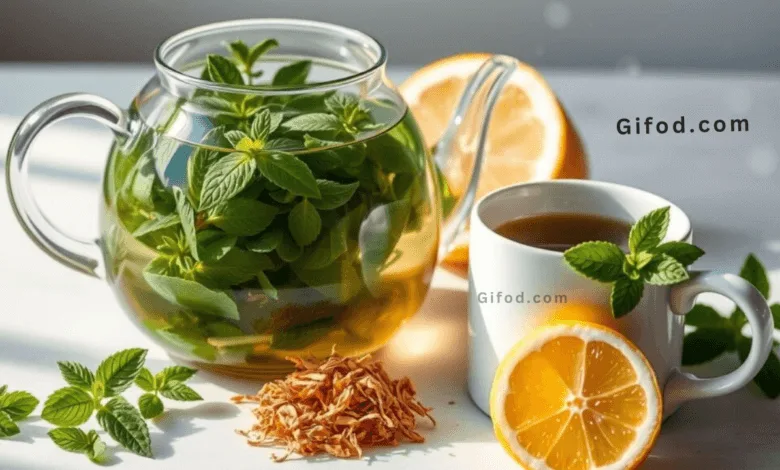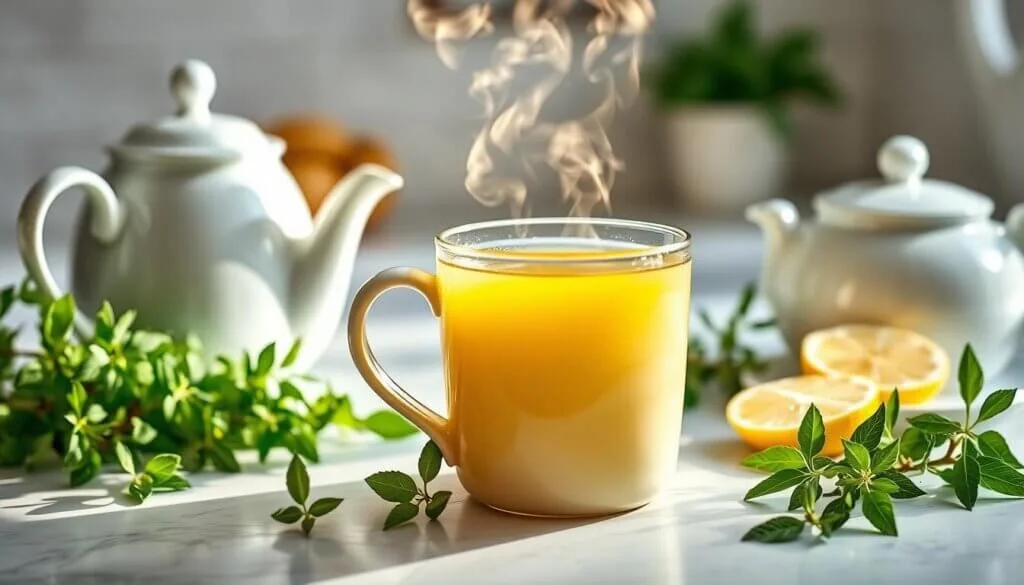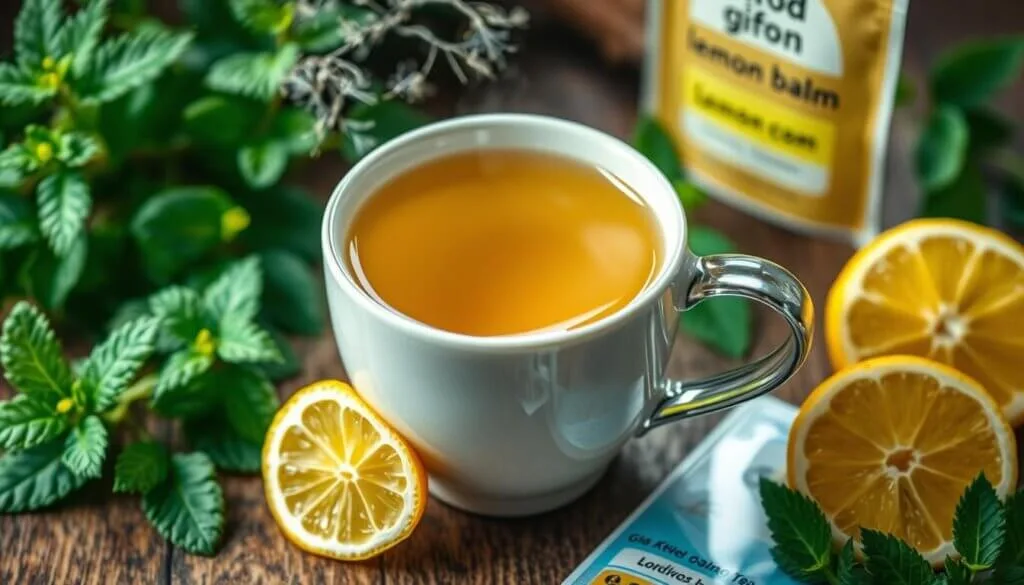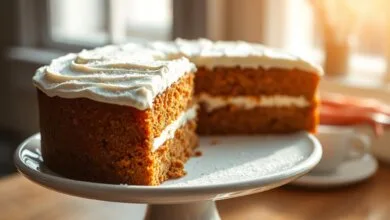how to make lemon balm tea 2025

how to make lemon balm tea: Imagine your next cup of tea could calm your mind, help you sleep better, and even protect your heart. Lemon balm tea is more than a trend; it’s a tradition that’s been around for over 2,000 years. It comes from the Melissa officinalis plant and has been used in kitchens and medicine cabinets since Ancient Greece.
Today, science backs up its benefits. It may help reduce anxiety, lower blood pressure, and even improve focus. But many wonder: how can you make the most of it at home?
I’ve been experimenting with homemade lemon balm tea for years. The results are impressive. Whether you’re using fresh leaves from your garden or dried leaves stored for months, this tea is powerful. It can help reduce stress and support heart health. This guide will show you how to brew it perfectly and why it should be part of your daily routine.
Key Takeaways
- how to make Lemon balm tea’s roots trace back over 2,000 years to Ancient Greece.
- Popular varieties like Lemonella (for cooking) and Citronella (for pest repellent) each offer unique uses.
- Proper brewing uses 1 tbsp dried leaves per 10 oz water, steeped 2-3 minutes for best flavor.
- Studies link it to improved sleep and reduced anxiety when made correctly.
- Pregnant women or those on medications should consult doctors before regular use.
Discovering the Magic of how to make Lemon Balm Tea
Lemon balm tea has been loved for centuries. It starts with the plant itself. This herb, from the mint family, has heart-shaped leaves that smell like lemon and mint.
Working with this plant feels like connecting to a tradition. It’s a tradition cherished in gardens and kitchens around the world.
Lemon balm (Melissa officinalis) grows in USDA zones 3–7. It spreads easily in sunny gardens. Its leaves have a crisp citrus scent, brightening teas and dishes.
It’s full of antioxidants like rosmarinic acid and vitamin C. It’s a natural powerhouse. I’ve grown it in my garden, and it’s a favorite for all gardeners.
Since ancient Greece, lemon balm tea has been brewed for wellness. Medieval healers used it to calm nerves, while Renaissance cooks added it to desserts.
Even today, its calming effects are a highlight. Monasteries in Europe grew it for its healing properties. Every sip connects us to this rich past.
There’s joy in plucking fresh leaves from my garden. Watching them infuse into golden tea is magical. The aroma alone lifts my mood.
I love experimenting with steeping times. 5 to 7 minutes is perfect. Making it at home means I get the best tea, without additives. It’s simple, refreshing, and a daily ritual I can’t live without.
Essential Ingredients for Perfect Lemon Balm Tea
Starting your homemade how to make lemon balm tea journey begins with the right ingredients. Fresh or dried lemon balm leaves are the star. Use 20 fresh leaves or 2 tablespoons dried for a standard pot. Always choose organic or pesticide-free plants for purity.
Pure filtered water works best; I recommend boiling it to 200–212°F. This unlocks the herb’s full flavor and health benefits like stress relief.
Optional extras elevate your lemon balm tea recipe. Try honey, lemon slices, or a dash of cinnamon. For herbal blends, mix 1 part lemon balm with 2 parts chamomile or mint.
When growing your own, harvest just before blooming for peak antioxidants. If buying dried leaves, look for brands like Traditional Medicinals or Starwest Botanicals. Ensure they’re pesticide-free.
- 20 fresh leaves or 2 tbsp dried lemon balm
- 4 cups filtered water
- Optional: 1 tsp honey, lemon wedge, or ½ tsp cinnamon
Steep time matters too—5–10 minutes for fresh leaves, 3–5 for dried. Experiment with ratios to suit your taste. Whether you’re brewing a calming bedtime tea or a morning pick-me-up, quality ingredients make all the difference. My go-to? A mix of lemon balm and mint for a refreshing twist.
Step-by-Step Guide: How to Make Lemon Balm Tea
Make a soothing how to make lemon balm tea with fresh or dried leaves. My steps are easy and focus on taste and convenience.

Fresh Lemon Balm Tea Method
- Pick 20–25 fresh leaves just before the plant flowers for peak aroma.
- Rinse leaves gently and pat dry. Crush lightly to release oils.
- Fill a teapot with leaves, pour boiling water, and steep 5–10 minutes. Strain before sipping.
Tip: Oversteeping can turn the tea bitter—taste after 5 minutes.
Dried Lemon Balm Tea Method
For dried leaves, measure 1–2 tsp per 8 oz water. Place in an infuser, pour hot water, and steep 4–5 minutes. Adjust time to taste.
Fun fact: Dried leaves retain flavor up to 6 months if stored in an airtight jar.
My Time-Saving Tips
- Pre-chop fresh leaves and freeze in ice cube trays for quick additions.
- Use an electric kettle for precise water temps—190–212°F works best.
- Batch-brew: Steep a large pot and refrigerate. Reheat or serve chilled over ice.
“Always crush dried leaves before steeping—it unlocks the full citrusy flavor!”
Try different ratios to find your favorite taste. This how to make lemon balm tea recipe is quick, whether you use fresh or dried leaves. Enjoy your tea in just 10 minutes!
Health Benefits of Lemon Balm Tea You Should Know
When I make lemon balm tea, I enjoy its citrusy taste and tap into herbal wisdom. The benefits of lemon balm tea include relaxation and digestion support, backed by science. A 2024 review shows it has calming effects, making it a gentle wellness ally. Let’s see how this tea can improve your daily life.
- Stress Relief: Studies show it reduces anxiety. In a 2019 study, 54% of heart surgery patients felt less anxious after using it.
- Sleep Aid: The IQP-AO-101 blend with lemon balm improved sleep quality in those with insomnia.
- Digestive Support: Traditionally used for stomach issues, a 2017 study found its extract protects against alcohol-induced ulcers.
- Menstrual Relief: Research shows it may ease cramps, with a 2017 trial noting reduced pain severity.
A 2024 analysis emphasized lemon balm’s potential to enhance psychological well-being through mild but consistent effects.
These lemon balm tea health benefits come from natural compounds in the leaves. While generally safe as tea, higher doses in supplements might cause headaches or digestive upset. Those with thyroid conditions should consult a doctor before regular use. Always start with small servings to gauge your body’s response.

My own experience matches these findings—I sleep better on nights I enjoy a cup before bed. But I always remind readers to pair this tea with professional medical advice for serious conditions.
Delicious Variations to Enhance Your how to make Lemon Balm Tea
Ready to try new flavors? These ideas will make your tea unforgettable. Here’s how I create unique blends.

Honey and Lemon Balm Combination
Adding honey can make lemon balm tea even better. Try these:
- Clover honey: It’s sweet but not too much. Use 1 tsp per cup to balance it out.
- Manuka honey: It has an earthy taste that enhances the tea. Great for after dinner.
Adding a lemon slice makes it even tangier. It’s my favorite!
Mint and Lemon Balm Fusion
Mix lemon balm with mint for a refreshing drink. My favorite mix is:
- Peppermint: It’s sharp and refreshing. Good for your digestion.
- Spearmint: It’s milder. Perfect for iced how to make lemon balm tea.
This mix helps with stomach issues and keeps you cool in summer.
Fruity how to make Lemon Balm Tea Blends
Try adding fruits to your tea for a twist:
- Steep blueberries or raspberries with dried leaves for a berry tea.
- Mango or pineapple chunks add a tropical taste when simmered for 5 minutes.
Cold brews are great for summer. My trick? Add fresh strawberries while steeping.
Storing Lemon Balm for Year-Round Tea Enjoyment
Keeping homemade lemon balm tea fresh is all about the right storage. Here’s my secret:
- Microwave Method: Place leaves on a plate. Heat on high for 30-40 seconds until they’re crisp. Let them cool before storing.
- Sun Drying: Lay leaves on parchment paper in the sun. Wait 1-2 days until they’re dry and brittle.
- Oven Drying: Preheat your oven to 180°F. Bake the leaves for 2-4 hours until they crumble easily.
- Dehydrator: Set the dehydrator to 95-115°F. Dry the leaves for 1-2 hours until they break apart.
I store dried leaves in glass jars or airtight containers. Place them in a cool, dark spot. Check them monthly for moisture. If they’re damp, re-dry them to prevent mold.
Freezing fresh leaves in ice cube trays with water is a quick fix. These cubes can last up to 6 months in the freezer. My go-to method is the oven—it gives me consistent results every time!
With the right storage, I can enjoy homemade lemon balm tea all year. Freshly dried herbs keep their calming scent and flavor. They’re perfect for a relaxing cup whenever I need it.
Potential Side Effects and Precautions
While lemon balm tea benefits many, it’s wise to consider individual health needs. My advice? Always prioritize safety alongside its calming effects.
Who Should Be Cautious When Enjoying This Tea?
Some groups may need to avoid or limit intake. Pregnant or breastfeeding individuals, those with thyroid conditions, or people preparing for surgery should consult a doctor first. Lemon balm’s mild sedative effects could interfere with anesthesia during procedures.
Those taking thyroid medications or sedatives like benzodiazepines should discuss interactions with their healthcare provider.
- Pregnant/bbreastfeeding women: limited safety data
- Thyroid condition patients: may affect hormone levels
- Upcoming surgery patients: avoid 2 weeks before procedures
Daily Serving Guidelines for Safe Use
Stick to 2–3 cups daily (1.5–4.5g dried leaves per cup). Exceeding this may cause stomach upset or drowsiness. A 2013 study noted safe use up to 6 months at 500mg daily, but no standard doses exist.
Over time, dependency may develop, with withdrawal causing anxiety or sleep issues.
Medications to Discuss with Your Doctor
If you take:
- Thyroid drugs: lemon balm may reduce their absorption
- Sedatives: avoid combining to prevent over-sedation
- Antiretrovirals for HIV: possible interactions
Always check with a healthcare provider before mixing with prescriptions.
While homegrown lemon balm is generally safe, store-bought supplements lack FDA regulation. Opt for reputable brands to minimize contamination risks like trace lead. Remember, how to make lemon balm tea benefits are real—but balance is key. Prioritize your health by consulting a professional if unsure.
Best Occasions to Serve Your Homemade Lemon Balm Tea
My favorite way to share best lemon balm tea is during moments that call for calm and connection. Its soothing properties make it perfect for unwinding after a busy day or as a thoughtful gesture at gatherings.
A 2004 study noted that lemon balm users felt calmer during lab-induced stress tests, proving its calming power.
Here’s when to serve it:
- Evenings: Sip it before bed to ease into sleep. Its mild sedative effects help quiet the mind.
- Wellness days: Pair with yoga sessions or home spa nights. The tea’s antiviral properties boost immunity too.
- Social moments: Offer at gatherings like garden parties or book clubs. Its citrusy aroma adds a fresh touch.
- Seasonal enjoyment: Serve hot during winter chills or iced in summer heat for a refreshing twist.
- Therapeutic times: Share it when someone battles stress, PMS, or minor ailments. Its oils like citral work gently on nerves.
Last weekend, I hosted a small gathering where guests raved about the tea’s calming effect. It’s my go-to for balancing moods, whether I’m sipping it alone or sharing with friends.
Conclusion: Embracing the Simple Joy of Homemade Lemon Balm Tea
There’s something special about drinking lemon balm tea made from fresh herbs. The vibrant green leaves and citrus scent bring calm, even on busy days. Making the lemon balm tea recipe is easy—just steep for 3-5 minutes and enjoy. With nearly 5,000 five-star reviews on Amazon, many agree.
Using it to relax before bed or trying new lemon balm tea uses like adding honey or mint is great. It’s caffeine-free and has a 4.5-star rating, showing it’s a top choice for relaxation. It helps ease stress in 20-30 minutes, making it perfect for those who want natural relief.
Try making a cup tonight, maybe with a walk in nature or a quiet evening. Share your favorite ways to make it, like mixing with lavender or chamomile, in the comments. The goal is to make it your own. Lemon balm tea is more than a drink—it’s a simple way to brighten your day. So, steep, sip, and enjoy the small joys.
FAQ
How do I make lemon balm tea?
To make lemon balm tea, you can use fresh or dried leaves. For fresh leaves, take about 20-25 leaves per cup. Steep them in boiling water for 5-10 minutes. For dried leaves, use 1-2 teaspoons per cup. Steep in boiling water for the same time.
You can enjoy it plain or add honey, lemon, or other herbs to enhance the flavor.
What are the health benefits of lemon balm tea?
Lemon balm tea is known for its calming effects. It helps reduce stress and anxiety. It may also improve sleep quality, soothe digestive issues, and alleviate headaches.
Its potential cognitive benefits may help improve focus and memory.
Can lemon balm tea have side effects?
Generally, lemon balm tea is safe for most people. But, it may cause drowsiness in some. People with thyroid issues, pregnant or breastfeeding women, and those on certain medications should talk to a healthcare provider before drinking it.
How can I enhance the flavor of my lemon balm tea?
To enhance your lemon balm tea, try adding natural sweeteners like honey or stevia. You can also add lemon slices for a refreshing twist. Or, mix it with other herbs like mint or chamomile for different flavors.
Experiment with different combinations to find your favorite!
Where can I buy quality lemon balm for tea?
You can find high-quality dried lemon balm at health food stores, online retailers, or specialty tea shops. Look for organic options when possible. Also, check that it has a rich aroma to ensure freshness.
How should I store lemon balm for the best flavor?
To store dried lemon balm, keep it in an airtight container in a cool, dark place. This helps preserve flavor and aroma. If using fresh lemon balm, store it in a glass of water in the fridge. Or, refrigerate wrapped in a damp paper towel.



